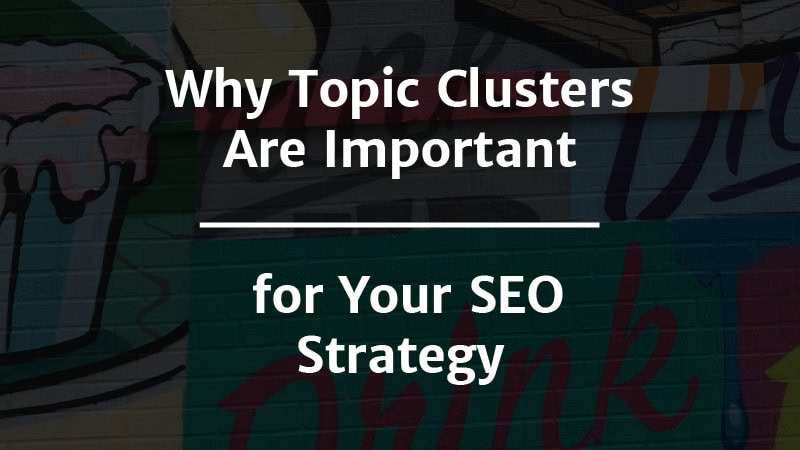Many businesses focus their search engine optimization (SEO) efforts on individual keywords. And this strategy can work. However, it can also lead to random articles that aren’t always relevant to the target audience.
If that’s your approach to SEO, it’s time to rethink your content strategy.
According to Google’s 2022 helpful content update, people-first content is given priority. Websites that provide visitors with high-quality, useful content rank higher.
When you focus on individual keywords, the information you can relay with one piece of content is limited. If you want visitors to keep coming back, you need to create a bank of information that goes beyond a single idea and covers all angles of the topic.
You can achieve this with topic clusters — topics related to a central idea that help you create high-ranking and highly relevant content for your audience.
In this guide, you’ll learn all about topic clusters, why they’re important, and how to use them in your SEO strategy.
Jump Ahead to a Specific Section:
What Are Topic Clusters?
Topic clusters are groups of keywords or subtopics built around a central main topic.
They let you cover multiple related keywords spread over several interlinked topics — establishing your website as an authority on the topic in the eyes of search engines and humans.
Many websites use the topic cluster strategy to establish authority and try to rank higher in search engine results pages (SERPs).
Topic clusters are made of two components: the pillar page and cluster pages.
- Pillar page: Gives a wide scope of a single topic, usually briefly defining several subtopics.
- Cluster pages: Expand on the information on the pillar page through dedicated in-depth pages for each subtopic.
Both types of pages are interlinked with each other through hyperlinks, which we will discuss thoroughly later in this guide.
For example, Hootsuite has a topic cluster around social media marketing:
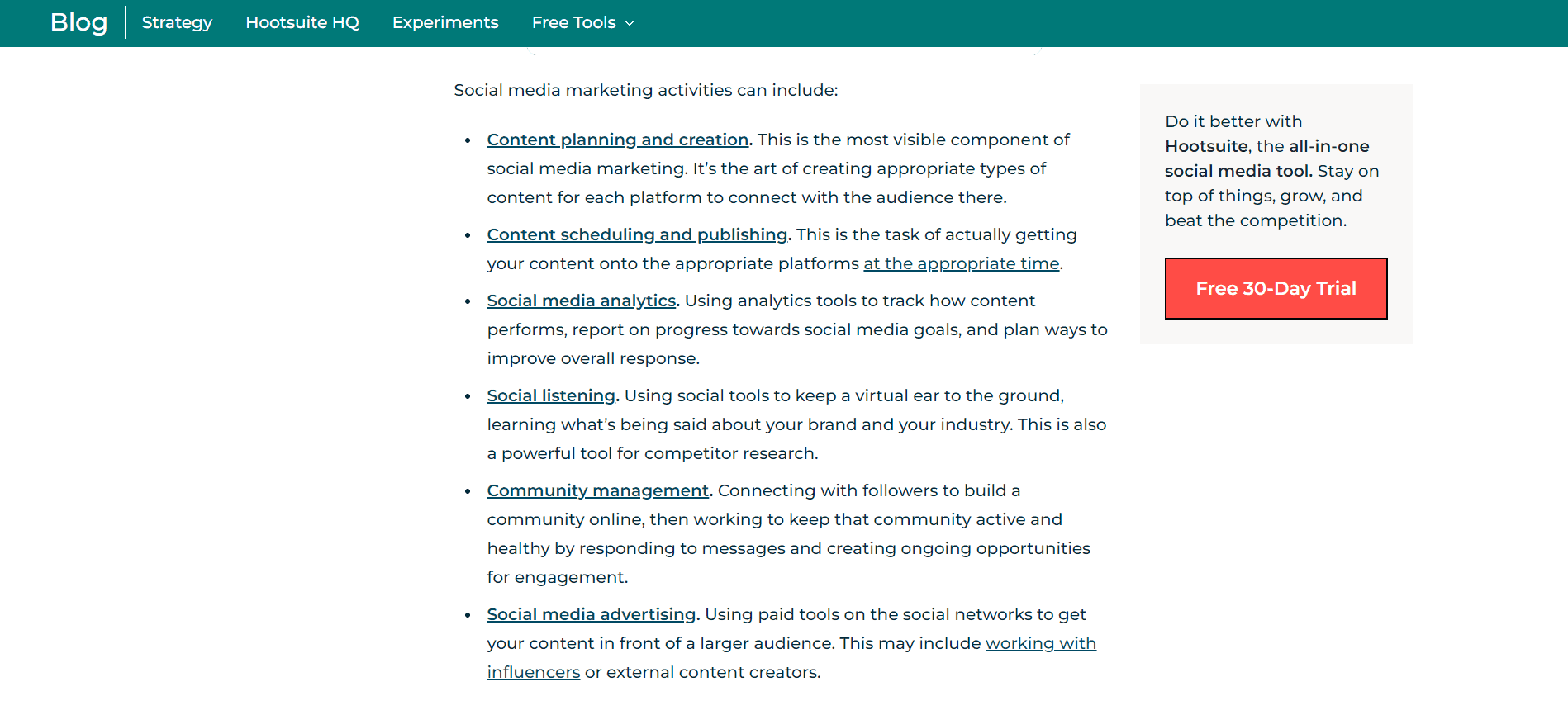
The pillar page, “What Is Social Media Marketing?” covers the basics of the topic and briefly introduces several connected topics, like social listening and content planning.
Each of these terms contains a hyperlink to the relevant cluster page that explains the topic in detail.
For example, if you click on “Social media analytics” on the pillar page, it will lead you to the article “What Is Social Media Analytics?”:

Similarly, if you click on “Social media advertising” on the pillar page, it leads to the article “Social Media Advertising 101,” which explains the tools and strategies used for advertising on digital platforms.
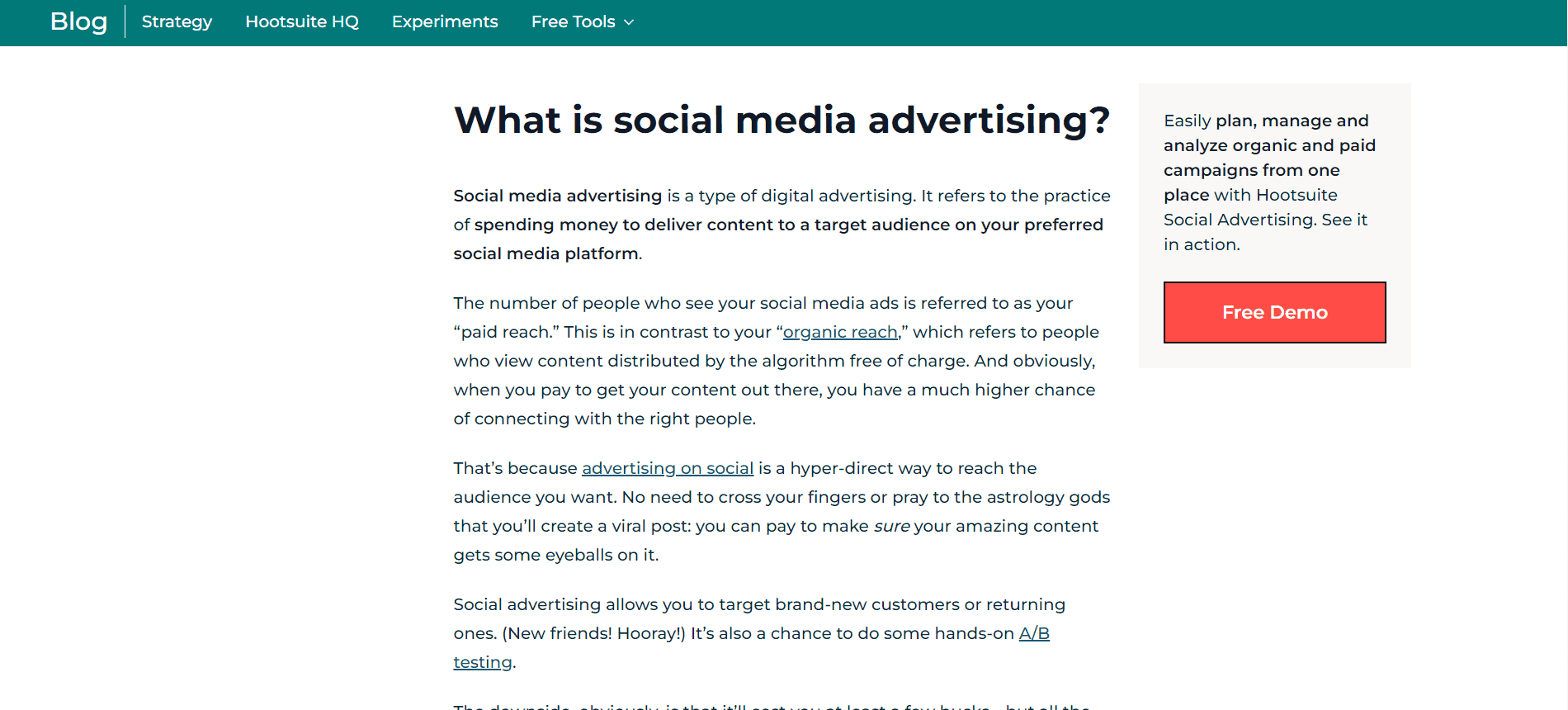
The cluster pages contain links to other subtopics, like “organic reach” and “social listening,” which helps the audience easily find in-depth information about a particular subject.
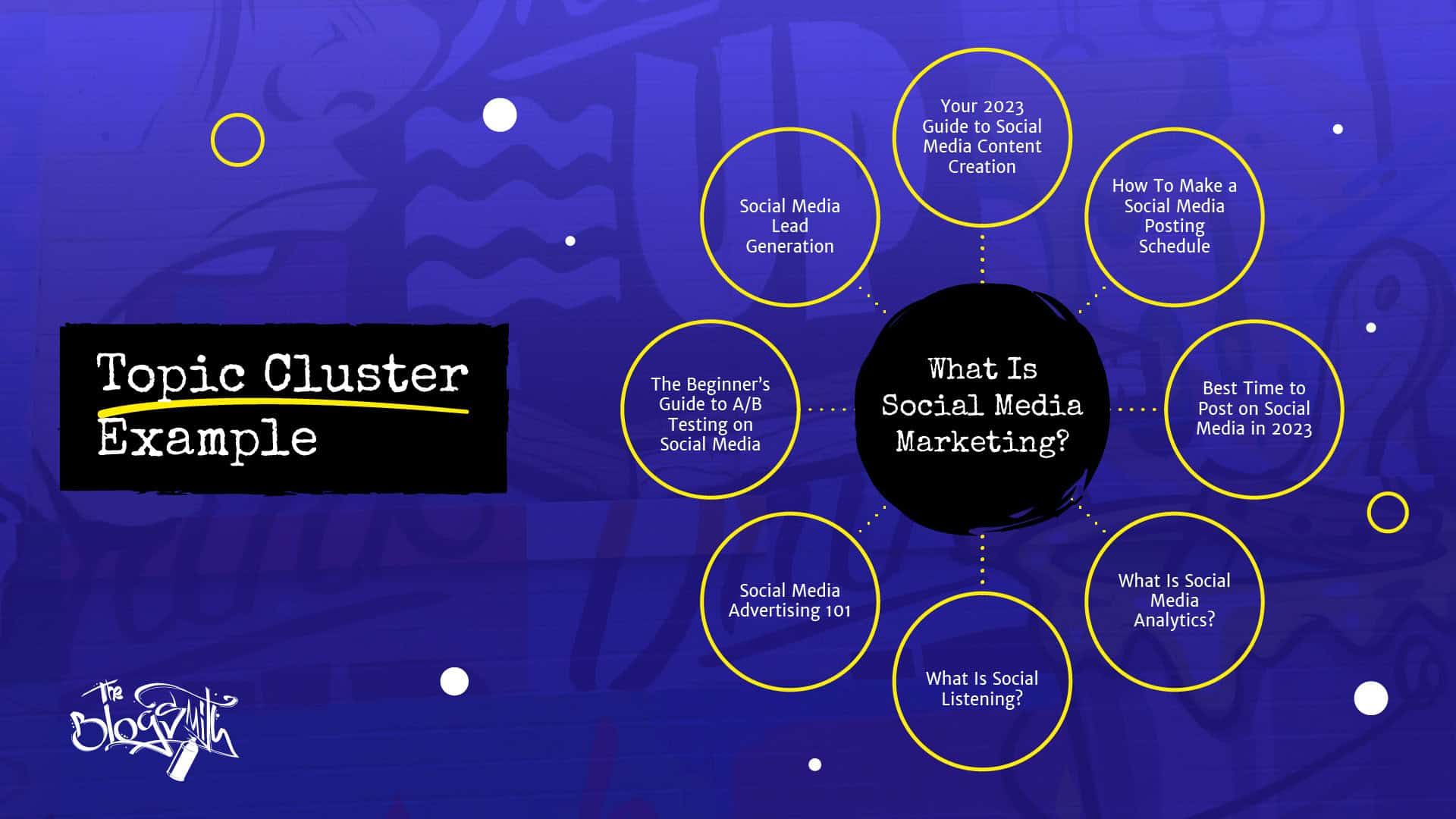
Readers who want to learn about social media marketing get a brief idea from the pillar page. If they wish to study any subtopic in-depth, they can find related information on the cluster pages.
Without the hyperlinks, both readers and Google would struggle to find and connect pages related to the topic. This would affect Hootsuite’s ability to establish topical authority, even if it had a number of pages about social media marketing.
So, how exactly do topic clusters help with SEO? Let’s find out.
Understanding How Topic Clusters Impact SEO
Topic clusters help you optimize content for a better user experience (UX), which is a crucial ranking factor.
Starting with the Hummingbird update in 2013, Google has increasingly focused on identifying the intent of search queries and displaying relevant results.
Subsequent algorithms, such as RankBrain, have helped the search engine understand search context through factors like past queries and user satisfaction.
As Google continues to alter its algorithms to make further improvements, you might need to adjust your content approach. Instead of creating content pieces that target individual keywords, you need to create a user-focused content strategy that ties your website together.
Using topic clusters simplifies this process by building an organized content scheme for your website. You can choose multiple areas of interest, create in-depth content around each topic, and link between the pages to improve relevance.
This helps Google identify information hierarchy and determine website ranking in two ways:
- The cluster pages comprehensively cover myriad content related to a single topic. That helps you establish your website as an authoritative source.
- The pillar page interlinks with the cluster pages, which helps Google identify it as the main page.
Website visitors also get a satisfactory experience due to the vast amount of relevant content on your website. Traffic might also increase as visitors click on various cluster pages for more information.
This prompts Google to identify your website as a credible source in the field, helping improve your search rankings.
Now, let’s see how topic clusters help with your human visitors.
Benefits of Creating Topic Clusters
Have you ever walked into a store to buy one item and then found five other things you just had to have while you were there?
Your readers could have a similar experience on your website. They come in to read one article but might also be interested in related topics.
But if you serve them isolated content pieces that have no connection with one another, readers might not have a reason to stick around.
Topic clusters address this problem by helping you fill your blog with supplementary information around a topic that your readers might find useful.
Here’s a closer look at some of the ways using content clusters can help your website:
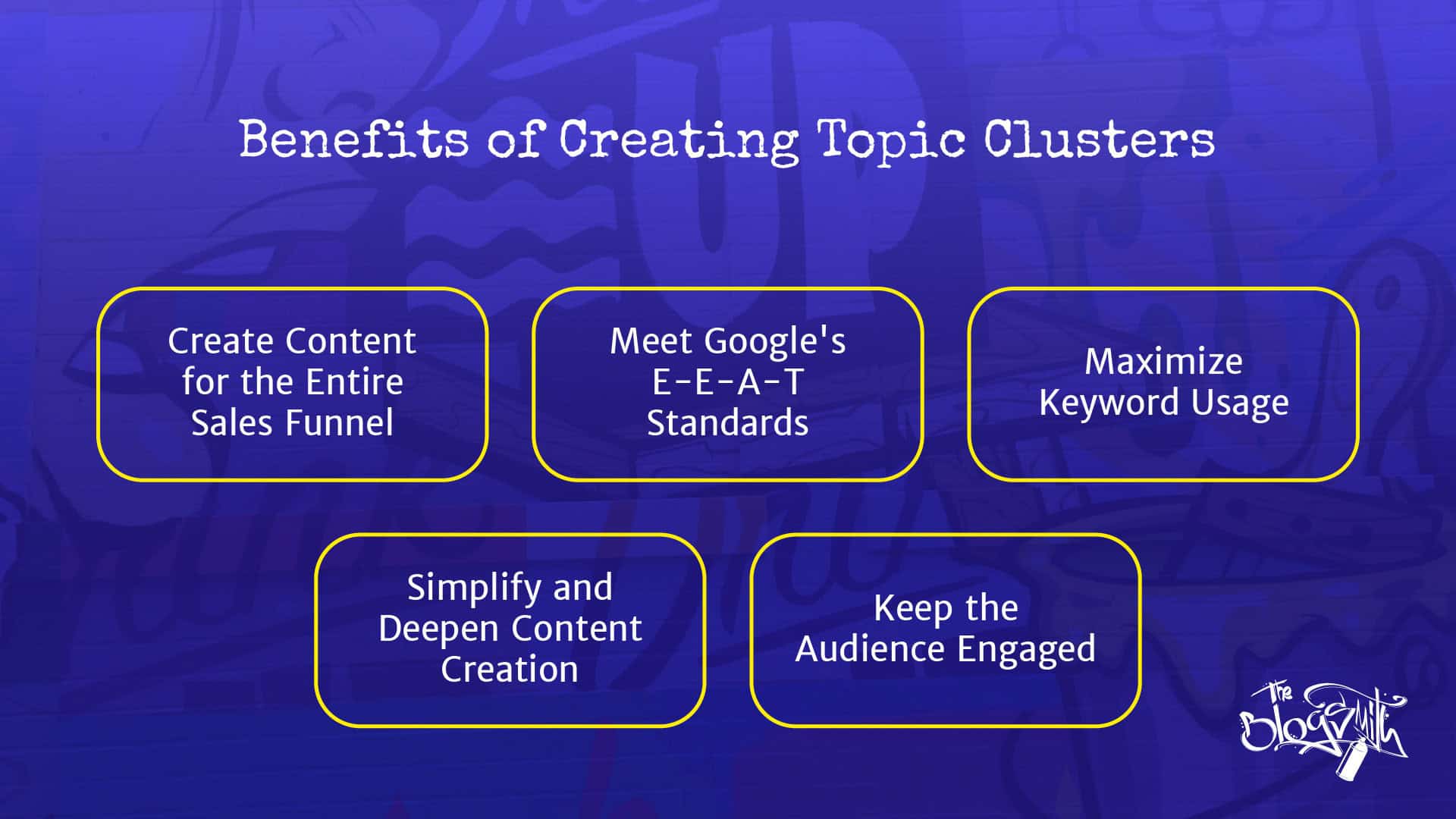
Create Content for the Entire Sales Funnel
Topic clusters help you create content for the entire sales funnel.
When potential customers look for content, their search intent will vary depending on their buyer’s journey stage.
A lead at the awareness stage has informational intent. They’re looking for content that answers questions like “what,” “why,” and “how.”
A prospect at the consideration stage has a commercial intent and looks for content that describes or compares similar products.
Someone at the decision-making stage has transactional intent. They look for pages that help them buy the product.
Finally, someone with navigational intent could be at the consideration stage (searching for particular products or brand pages) or the retention stage (looking for help using the product).
But no matter what stage of the buyer’s journey your readers are on, you can offer content they’ll find useful.
According to a Demand Gen report, 42% of B2B buyers go through three to five pieces of content before talking to a salesperson.
So, it’s essential to guide leads through the sales funnel with relevant content to convert them into customers.
Topic clusters help you bring in relevant traffic, provide useful information, and make sales through content that caters to all buyers looking for information about a single topic.
The broader pillar content attracts top-of-the-funnel (TOFU) leads. The more specific pages direct customers toward purchasing by offering middle- (MOFU) and bottom-of-the-funnel (BOFU) content.
Here’s an example of how topic clusters help create content for the entire sales funnel:

A visitor who wants to learn about social media analytics for their business may not be aware that they want a tool. But as their curiosity leads them from the pillar page to various cluster pages, they gradually warm up to needing an analytics tool and choosing one based on the options you provide.
Meet the E-E-A-T Standards
If you want to rank higher in SERPs, you need to satisfy Google’s E-E-A-T standards. These standards — Experience, Expertise, Authority, and Trustworthiness — ensure websites are providing useful, pertinent content.
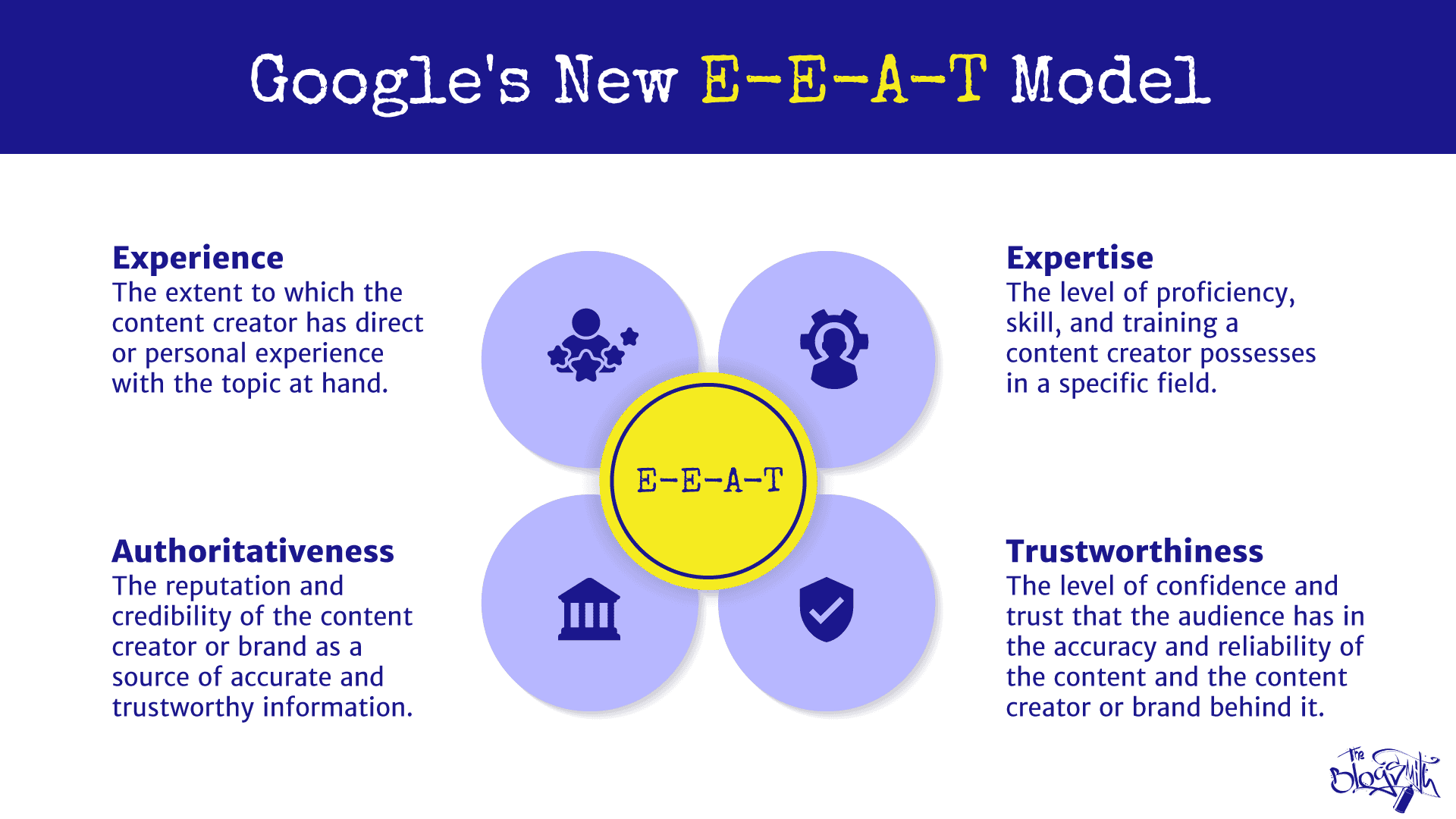
Meeting them will help you gain higher visibility in the search results. Since the top-ranking pages get the most clicks, your website should see more organic traffic when you boost your visibility. In fact, websites that snag the first position on Google get an amazing 27.6% of all clicks.
Using topic clusters can help you optimize content for all aspects of E-E-A-T:
- Experience: If you have experience in multiple niches in your field, topic clusters can help you come up with dedicated pages for each area.
For example, if you’re an experienced digital marketer specializing in influencer marketing, you don’t need to speak about all of that in a single article related to online marketing.
Instead, you can create two separate pages about digital marketing and influencer marketing. Dividing your experience into cluster pages also increases its relevance to readers.
- Expertise: To get really granular about a niche topic and demonstrate expertise, you’ll need multiple pages. Topic clusters help link these pages to create a broader, interconnected database for your readers. They also open up opportunities to tap subject matter experts.
For example, if your website deals with FinTech, you can invite multiple experts to share their opinions on the same topic, such as investments. By interlinking these articles through the pillar page, you’ll help your readers make informed decisions by quickly accessing multiple perspectives through a single website.
- Authority: For Google to identify your website as an authority source, your website needs multiple pages on the same topic. Topic clusters help the search engine identify related pages to recognize your website as a topical authority.
- Trustworthiness: High-quality content with proper organization, accuracy, and interlinking shows your website is trustworthy.
Maximize Keyword Usage
It’s easier to optimize content for short-tail keywords, as you can use them in a broader sense. But targeting only short-tail keywords isn’t enough to boost your brand’s visibility and potential sales. You also need to include long-tail keywords.
A short-tail keyword can be something like “content marketing.” A long-tail keyword is highly specific, such as “how to create a content marketing strategy for small businesses.”
The difficulty of using these more specific terms in generic content is outweighed by the benefits. For instance, 10- to 15-word keywords have a 2.62-times-higher click-through rate (CTR) than one-word terms.
Topic clusters can help you work in these tricky terms. The pillar content can cover the short-tail keywords and use longer phrases to link out to the related pages. Then, the cluster pages can focus on more specific keywords.
This is an especially useful tactic for businesses with multiple locations that require local SEO.
For example, an SEO content business can create a pillar page targeting the keyword “SEO content service.” Then, it can link several cluster pages that target local keywords, like “SEO content in Denver,” “SEO content for New York companies,” and “top SEO content services in the U.S.”
Simplify and Deepen Content Ideation
With topic clusters, you don’t randomly create content for your website. Instead, you use an organized content structure that revolves around core topics.
New content ideas for cluster pages will start to pop up once you create the core content.
Here’s an example from a cluster about home loans:

However, a well-thought-out topic cluster gives results beyond simply having sufficient content on your website. It also enhances your website’s navigation and neatly organizes your blog, improving your UX.
It also gives you a chance to cover a topic thoroughly by answering any questions your readers might have. Your readers will feel heard, which strengthens their trust in your brand and warms them up for future sales.
And since your content is organized, you avoid accidentally creating similar pieces.
Keep the Audience Engaged
Potential customers might visit your website looking for information on broad topics. As they continue reading, they want to learn more about specific subtopics or terms.
It’s technically possible to cover almost everything about a subject on a single page. But the article could become too long and tedious. Readers might lose interest and switch to a different website before finding the information they actually need.
But, if you don’t cover enough about a topic, readers will move to websites that answer their queries.
High-quality long-form content tends to do well on SERPs, even though word count isn’t an explicit ranking factor. According to Semrush, pillar pages with over 3,000 words bring in the most organic traffic.
Topic clusters help you balance these requirements. You can explain broader topics through the pillar page and redirect readers to cluster pages to learn more. This tactic helps you deliver all the required information while keeping the audience engaged.
Now, if you have a lot of related content on your website, you might not think you need clusters. But they can also give your website’s organization a leg up.
If related content pieces are difficult to find, then readers won’t get the information they’re searching for. But with help from topic clusters, you can make your content easier to navigate, which can lead to an increased Time on Site (TOS).
How To Create Topic Clusters for Your Website
To reap the benefits of using a topic cluster model, you need a step-by-step plan built for your business. You’ll need to identify core areas of interest, conduct keyword research, and organize your content.
Here’s a breakdown of how to use topic clusters in your content marketing strategy.
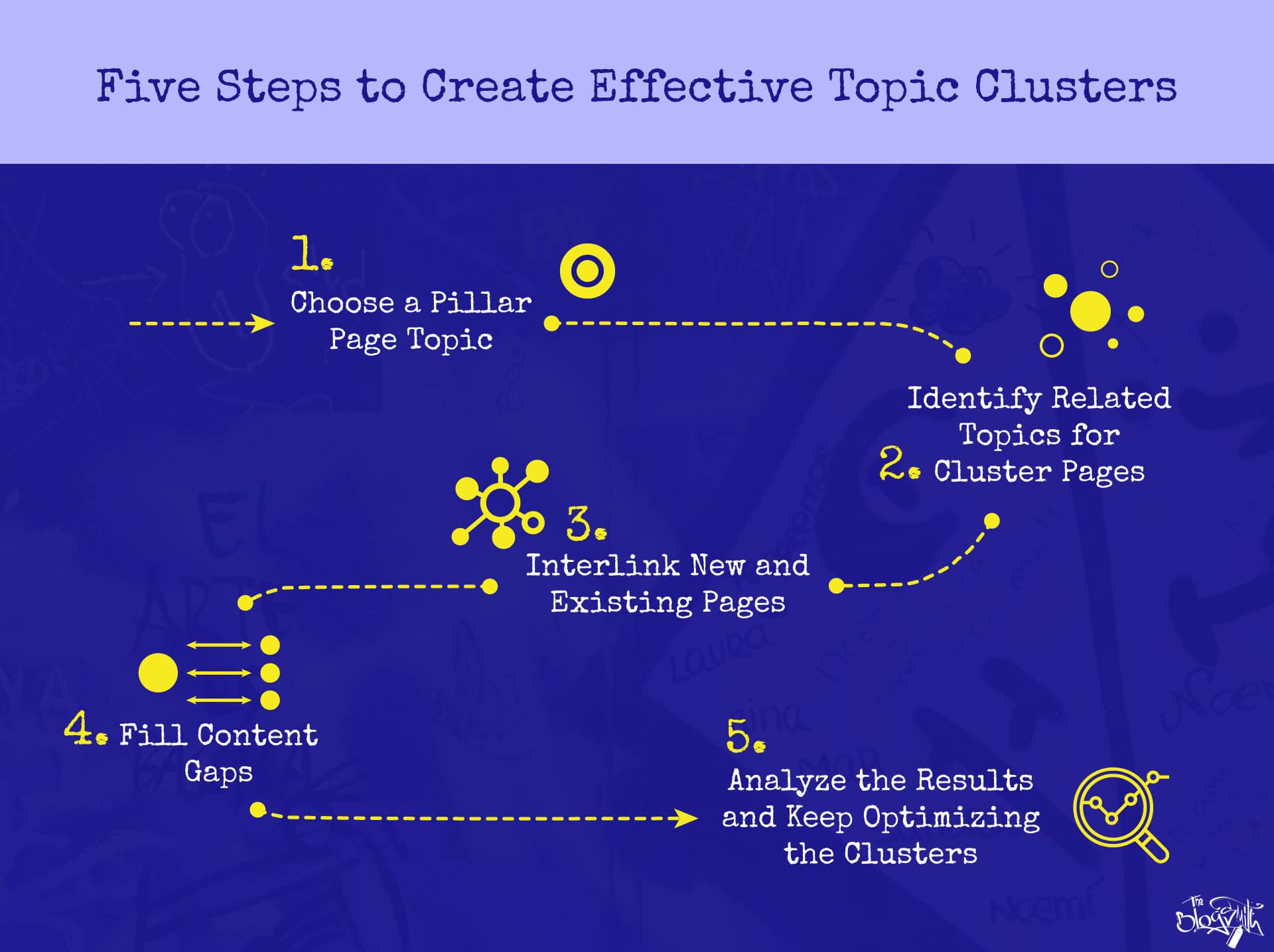
To put it simply, SEO helps more folks find and visit your website, and it involves optimizing your content not just for humans but also for robots. To find out more about how to do that, check out The Blogsmith Founder Maddy Osman’s book, Writing for Humans and Robots: The New Rules of Content Style.
But here’s the other thing: SEO includes a significant investment of time, resources, and — yes — good ol’ dollars. As with any other endeavor, you want to know that the reward is worth the investment. After all, you don’t want to be putting time and resources into something that’s not working.
Measuring your SEO ROI has many other benefits. For example, SEO ROI also helps you:
1. Choose a Pillar Page Topic
The entire topic cluster for your website will be based on the central pillar page. That’s why it’s essential to choose a topic that’s broad and related to your product or service.
The pillar page topic should:
- Make way for several subtopics for cluster pages.
- Attract potential customers who are still at the initial awareness stage.
- Have a high search volume.
You can create several pillar pages by choosing different core topics to zero in on or just stick to one topic to begin with.
For example, a digital marketing company can create a pillar page around the keyword “what is digital marketing.”
This keyword is broad enough to provide a general overview of the company’s services and generates enough subtopics for related pages.
However, don’t limit yourself to targeting low-difficulty keywords when creating pillar pages. As the pillar page topics are often competitive, you need to focus on having in-depth content that can easily connect to cluster pages.
While this is possible with low-difficulty keywords, pillar pages typically use high-difficulty keywords that are 2-3 words long.
2. Identify Related Topics For Cluster Pages
Many cluster page ideas may naturally stem from the pillar content. But it’s important to identify what your audience wants before creating extra pages.
You can use search engine features like Google autocomplete, people also ask (PAA), and related searches to understand what people are looking for.
Consider the marketing company example. A quick Google search on “what is digital marketing” gives several content ideas in the related searches section:
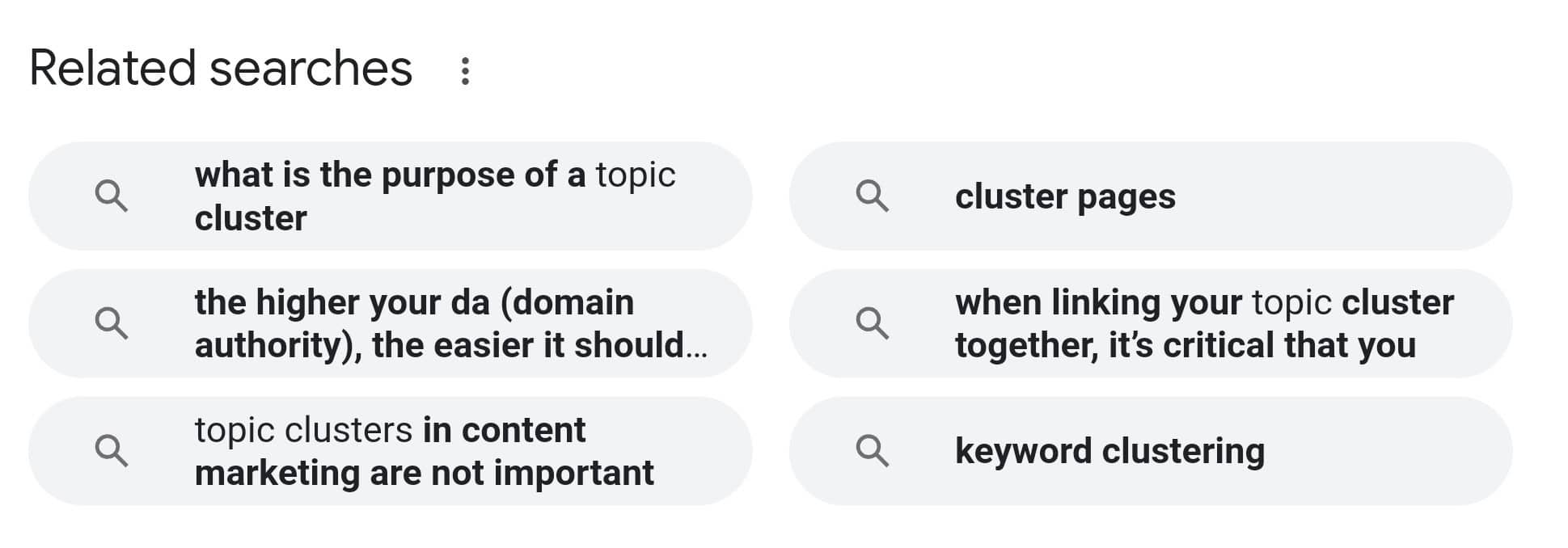
The topics “types of digital marketing,” “importance of digital marketing,” and “how to start digital marketing” would be excellent additions to the cluster.
You can also use tools like Answer The Public and Topic Research by Semrush to find cluster content ideas.
Once you’ve selected a few topics, conduct keyword research to find relevant long-tail keywords. Since cluster pages are more specific, they provide better ranking opportunities for long-tail keywords that might end up sounding awkward if you try to force them into general articles.
What’s more, building topic clusters can help you discover relevant low and no search volume keywords that your target audience is specifically searching for.
3. Interlink New and Existing Pages
After creating the pillar and cluster pages, it’s time to interlink them. This helps Google identify the content hierarchy.
As mentioned before, these internal links help a website gain authority. They also eventually lead to backlinks to your website as other businesses identify your page as authoritative and trustworthy.
According to Authority Hacker, backlinks are the most important Google Search ranking factor.
When you use topic clusters, building internal links is a piece of cake. You just need to add hyperlinks from the pillar page to the cluster pages and vice versa. You can also interlink between cluster pages if they have relevant anchor text.
To find more linking opportunities, you should also look through your website’s existing content.
For example, suppose the marketing website already has a “Digital Marketing for Small Businesses” page. The team can add links between that page and the “What Is Digital Marketing?” pillar.
HubSpot’s digital marketing pillar page is an excellent example of interlinking. The article makes it easier for readers to navigate to cluster pages while also being fun, engaging, and not too focused on the links.
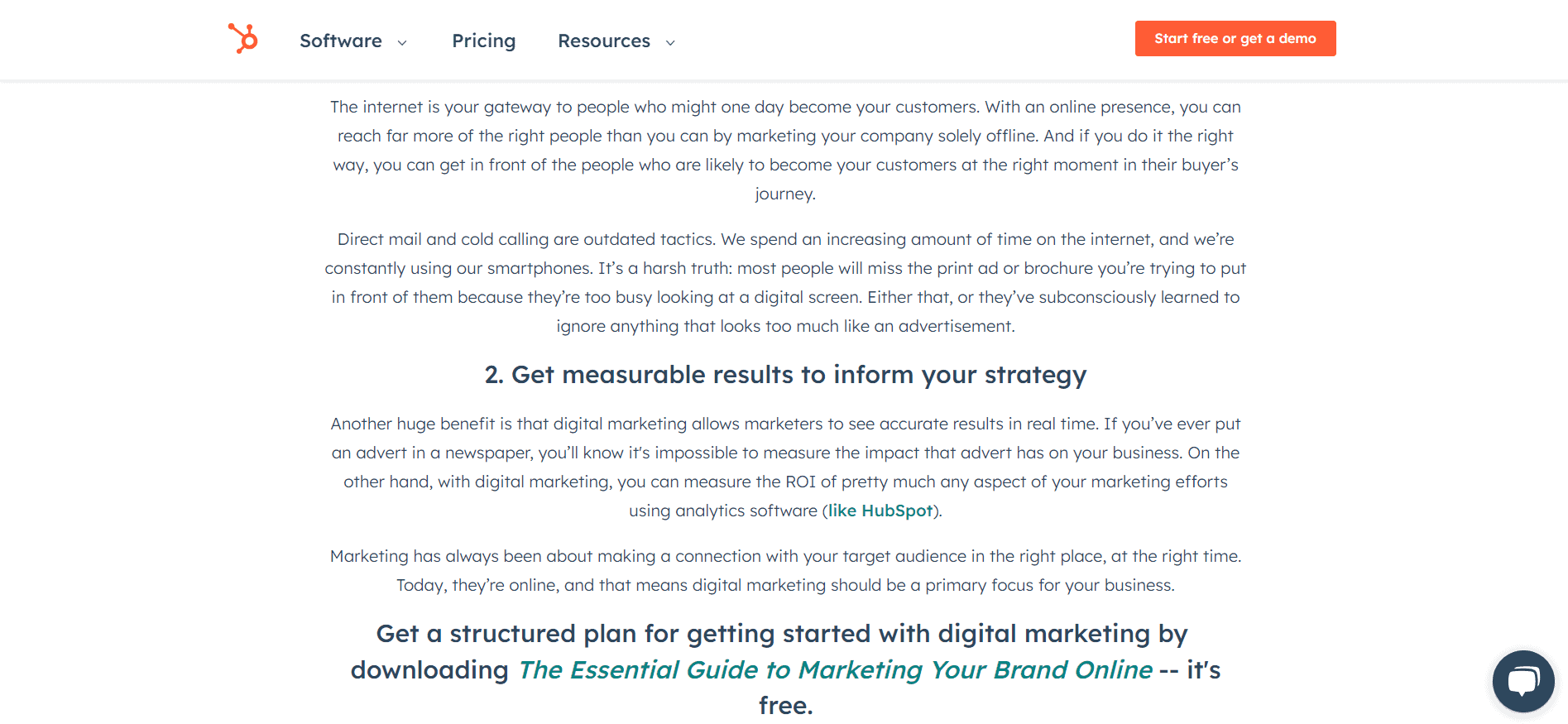
4. Fill Content Gaps
Even if you have created a large number of webpages in a topic cluster, you’ll find content gaps down the road.
Perhaps you skipped creating a page because the keyword didn’t have a high search volume. Or a recent report on the pillar subject has given rise to new subtopics.
Identifying these gaps and creating relevant content pages is essential for building authority.
This also gives you an opportunity to create in-depth content resources that can be used internally by your employees and executives.
Perhaps your marketing team needs a dedicated guide on how to convert customer success stories into social media content. While this resource is primarily meant for your internal team, other readers can also find it helpful.
Consider The Blogsmith’s Writing Style Guide, for instance. Our writers and editors regularly use this resource. But the published guide is also helpful for other marketing teams and freelancers who need some direction on how to create good content.
5. Analyze the Results and Keep Optimizing the Clusters
Building topic clusters isn’t a one-and-done process. You’ll need to measure their effectiveness and optimize them regularly.
One of the best ways to measure the success of topic clusters is to track how the pages perform.
Is the pillar page ranking higher than before? Where do the various cluster pages rank? What clusters are gaining the most clicks and traffic? What long-tail keywords do the pillar and cluster pages rank for?
A pillar page that ranks higher brings more organic traffic to both the cluster pages and the website in general. This, in turn, leads to the potential for higher clicks, conversions, and revenue.
By optimizing the pillar content, you can easily measure the return on investment (ROI) of your topic clusters by analyzing the amount of traffic each topic category brings to your website.
Apart from using a content analysis tool to gauge your content’s effectiveness, you should also keep up with industry trends to identify any potential content gaps. Then, add new cluster pages to accommodate changing user interests and search intent.
Let’s go back to the digital marketing example. If you notice an increase in searches for “influencer marketing on LinkedIn,” you can create a cluster page about the topic and link it to your pillar.
It’s also important to update your pillar page regularly to target important keywords. For instance, if you’ve created a new cluster page, the pillar content should be updated to include that keyword and link to the new page.
Now that you know how to create a topic cluster strategy that caters to your target audience, it’s time to focus on boosting clusters’ SEO.
Tips for Creating Effective Topic Clusters for SEO
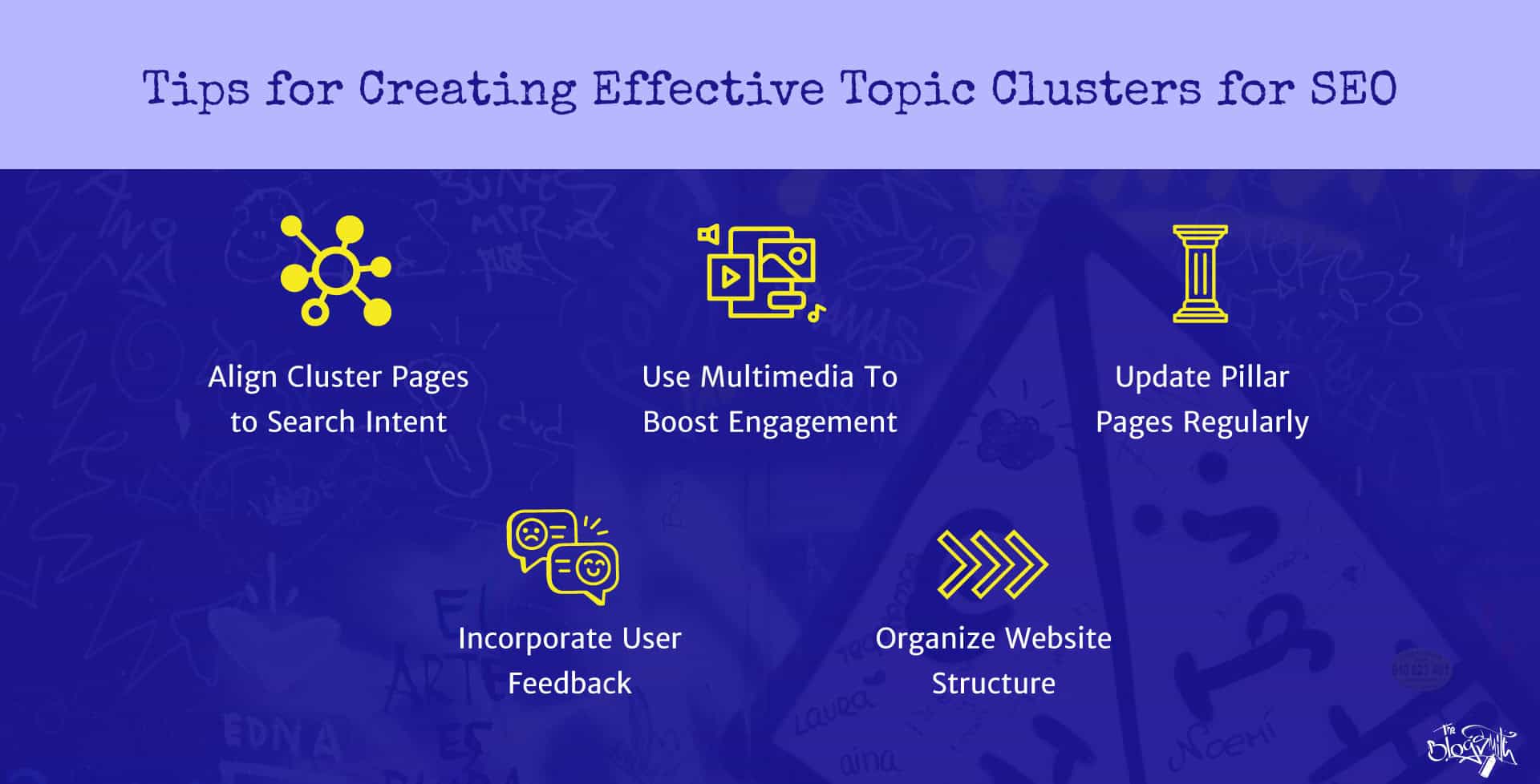
While content quality and relevance help content rank higher, you can further boost your topic clusters’ performance by focusing on some SEO best practices. Following these tips will help your pages rank better:
Align Cluster Pages to Search Intent
Google uses search intent as one of the main factors while ranking websites. So, you need to optimize cluster topics to suit various types of search intent in addition to using target keywords.
Usually, most queries can be divided into four categories, depending on the search intent:
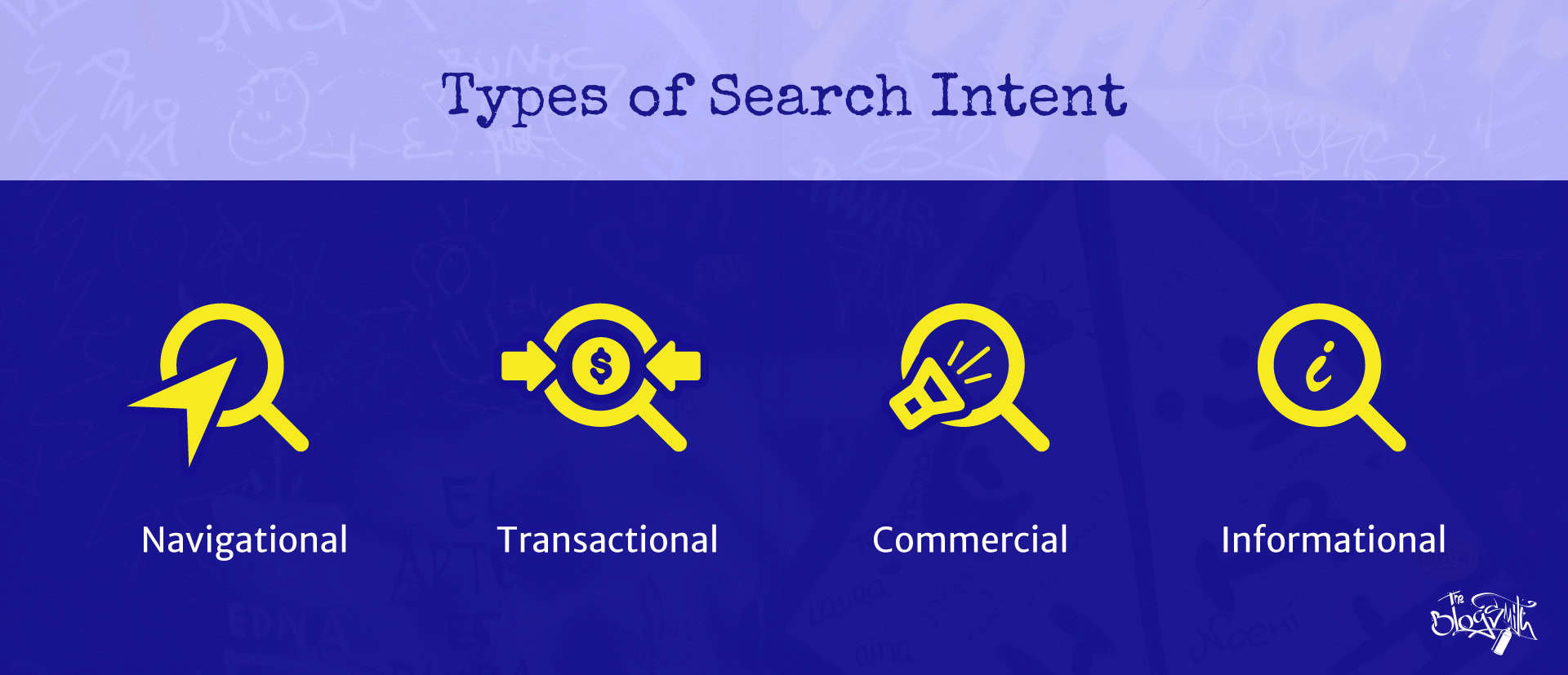
For example, pages like “How To Create a Basic Web Design?” and “Why Is Web Design Important?” satisfy informational intent. On the other hand, “The Best Web Design Agencies in 2023” targets users with commercial intent.
Similarly, product or landing pages like “Download the 2023 Web Design Analysis Report” work well for navigational intent. For transactional intent, you’ll need something like “Start Our 1-Week Free Trial” or “Buy Our Premium Web Design Package.”
To provide a good UX and draw in more visitors, you need to offer content that caters to each type of search intent.
Use Multimedia To Boost Engagement
Topic clusters aren’t limited to text-based content pages. You can also link to videos, infographics, or text-multimedia combo pages.
Using videos and images makes your content more interesting and inclusive. People who can’t or don’t want to read can still access the required information through your website.
Not to mention, images and videos make reading fun. You don’t want to serve blocks of text to readers who love consuming visual content.
Update Pillar Pages Regularly
As your industry evolves, you’ll find more keywords and topics to include in the clusters. But making an entirely new topic cluster from scratch to accommodate these changes isn’t feasible.
Instead, regularly refresh content in the pillar pages to include the updates and create new cluster pages to explain the new terms in detail. This helps keep your content relevant.
Incorporate User Feedback
Incorporating user feedback is essential, especially when updating existing topic clusters. This includes feedback on not only the content but also your product or service in general.
You can obtain customer opinions by looking through your own experiences. What do your clients frequently ask? What’s something they like about your product?
Say you run a web designing agency that specializes in creating budget-friendly websites. If your clients always compliment the quality of your designs, you could create a cluster page highlighting some of your best work.
Or, if potential clients repeatedly ask about your offers for small businesses, you could create an FAQ page about that topic.
The key here is to create content that your target audience actually wants to read.
Not sure what your customers are interested in?
Create surveys or simply ask your readers what they want to know more about at the end of an article. That way, you’ll get direct user feedback to either improve an existing page or create a new cluster page.
Additionally, you can use social listening tools like Hootsuite and Sprout Social to understand what people say about your brand on social media.
This feedback might also provide content opportunities that are unique to your business.
Organize Website Structure
Since topic clusters contain multiple pages and a huge amount of data, navigating through the pages can be difficult. An organized website structure makes navigation easier by linking related pages.
You can use a hierarchical structure to help visitors easily reach cluster pages, like this content marketing guide from Moz:
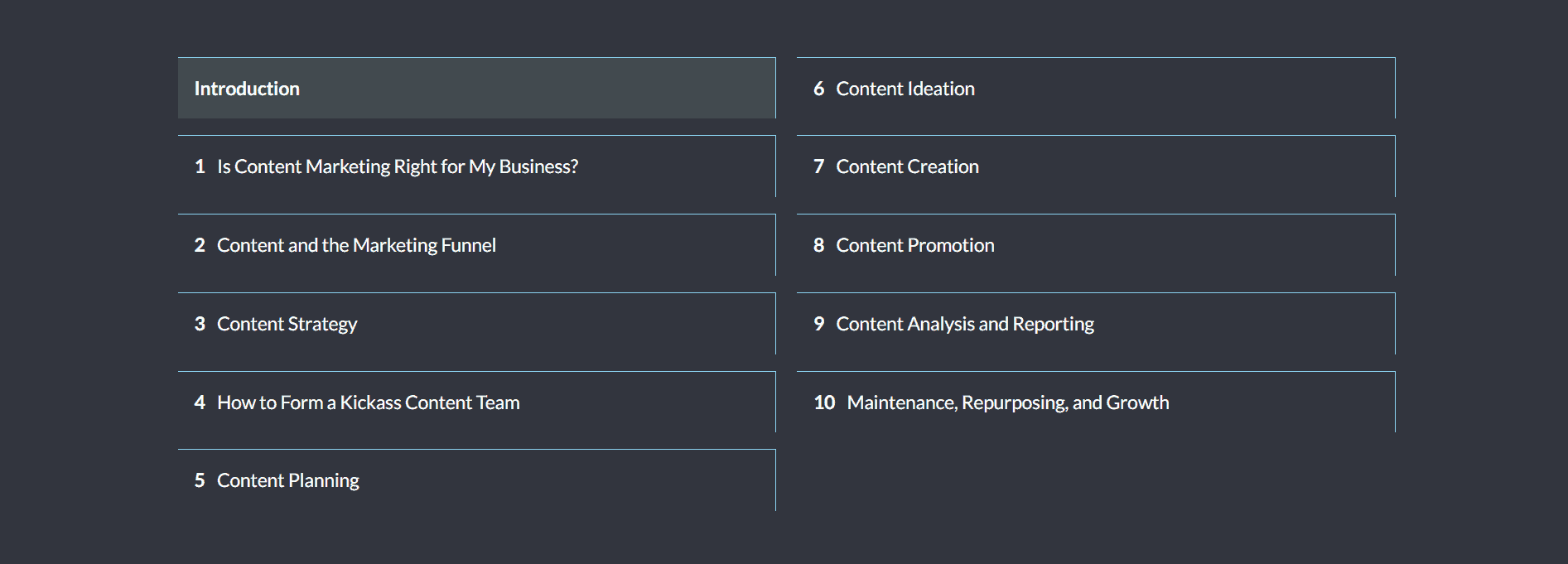
Your potential customers will also love a tidy website. It makes the content easily accessible for visitors and also helps you with content analysis — a win-win!
Final Thoughts: What Are Topic Clusters, and Why Are They Important for SEO?
Creating topic clusters is an absolute must for your SEO strategy, as they improve content relevance and provide an organized structure for your website. Plus, they help build a positive UX by creating an easily accessible content structure for your readers.
Many brands also use topic clusters to showcase their experience and expertise in their respective fields.
If you want to establish yourself as an authority and build a better brand image, creating topic clusters is one of the best content strategies you can use.
However, identifying topics and creating content that satisfies both search engines and your audience can be tricky. If you’re looking for a reliable content agency that can create relevant, optimized topic clusters and help with a robust content plan, then reach out to The Blogsmith.

